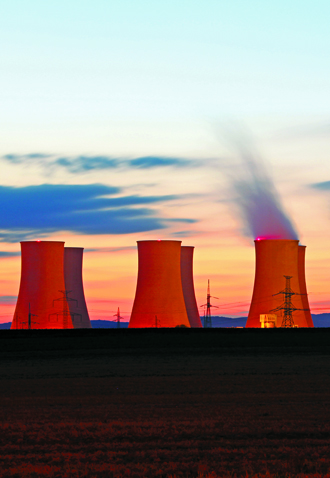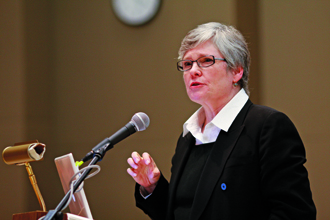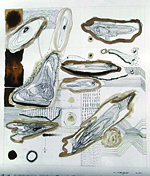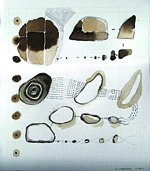Oberlin Alumni Magazine
Summer 2012 Vol. 107 No. 3
Speaking Truth to Nuclear Power

On the anniversary of the Fukushima disaster, Kennette Benedict '69 wants to bring the nuclear industry into the sunlight.
Although now more than 80 years old, the nuclear age is still in its infancy, and it is a problem child. Born during wartime, it spent its formative years being molded into a weapon of mass destruction. Later, the nuclear age offered to a devastated world the promise of a clean, renewable, and abundant new source of energy. But the ongoing catastrophe at Japan's Fukushima nuclear power plant is an immediate reminder of the hazards inherent in exploiting what Kennette Benedict '69 has called "the most dangerous technology on Earth."
For more than two decades, Benedict has been an advocate for the responsible stewardship of our nuclear legacy. As director of international peace and security for the John D. and Catherine T. MacArthur Foundation, Benedict established and directed a nuclear arms reduction initiative in the former Soviet Union.
Since 2005, as editor and publisher of the Bulletin of the Atomic Scientists (a magazine established by Manhattan Project scientists in 1945), she has worked to encourage a deeper public discourse and greater transparency in the nuclear power industry.

THE FUKUSHIMA SYMPOSIUM: Lessons Learned, brought together a multidisciplinary panel of participants to discuss the complex technical, social, and political issues arising from the Fukushima disaster. Pictured is Kennette Benedict '69 during her talk. (John Seyfried)
In an industry largely shrouded in secrecy, Benedict doubts the possibility of the kind of open public debate that might lead to a better, safer nuclear future. The dangers remain mostly hidden; the full potential remains unexplored.
As Benedict observes, the discovery of nuclear fission at a time of war set the world on a path to nuclear power that began with development of nuclear weapons "out of fear — in haste and in secrecy."
Nuclear power offers "10 million times more useable fuel per unit than chemical fuel such as coal or gasoline, and it contributes little to no carbon emissions," Benedict says. In this context, President Obama's renewed commitment to nuclear energy seems less paradoxical than inevitable.

A significant portion of the global energy budget comes from nuclear energy. About 40 percent of the energy needs of Switzerland and Sweden, and more than 70 percent of France's, are satisfied through nuclear power. Before Fukushima, 30 percent of Japan's energy budget came from nuclear sources. It provides 20 percent of the energy in the United States. But there has not been a new reactor built in our country in almost 30 years.
The earliest reactor plants, the boiling-water reactors (BWR), were designed to power nuclear submarines and, Benedict notes, developed with little regard to cost, efficiency, or safety. They are what Oberlin Professor of Environmental Studies David Orr has appropriately described as "a dangerous and expensive way to boil water."

Many of the 104 active reactors in the United States are BWR reactors, as were the reactors at Fukushima. In the 32 countries with active nuclear reactors, the BWR design dominates. Most of the power plants in the U.S. have already outlived their anticipated lifecycle and remain active simply because there is no clearly viable alternative.
Faced with the prospect of a new generation of nuclear reactors, Benedict believes the debate must shift from pro- or anti-nuclear power to "a choice between equally unsatisfactory alternatives."
"I think that money put into research and development of different designs for nuclear reactors might be worthwhile," she says. "We haven't in the past really looked for safe nuclear designs."

Safer designs exist, including small modular reactors, which Benedict says offer the kind standardization in design that the current reactor fleet lacks. "And they're smaller so that if they do blow up, it's not these huge amounts of material."
The problem is not technological but economic. With estimates for new construction as high as $18 billion, the industry is reluctant to bear the additional costs of developing new designs. But continuing down the present path, Benedict says, may lead to more disasters like Fukushima, or worse.
Above images:
ETERNAL FLAME: Sunday, March 11, 2012, marked the first anniversary of the disaster at the Fukushima nuclear power plant. It began with the Great Tohoku earthquake, a 9.0 magnitude undersea megathrust, which set in motion a massive tsunami that devastated the Japanese coast and led to the meltdown of three reactor cores at the Fukushima plant.
The tsunami claimed more than 10,000 lives and, along with the nuclear disaster, uprooted more than 100,000 people from their homes.
Oberlin Shansi and Oberlin College acknowledged the anniversary by cosponsoring a symposium and art exhibition, The Fire That Doesn't Go Out, which explored the broad existential issues of life in the nuclear age.
Curated by Associate Professor of Art Nanette Yannuzzi and Associate Professor of Creative Writing Sylvia Watanabe at the Baron Gallery in downtown Oberlin, the exhibit included works by Marianna LaRosa Maruyama '02, an American Italian artist working in Tokyo; Alison Meyers-Ohki '11, a fourth-generation Japanese American artist; and Sarah Schuster, associate professor of studio art at Oberlin.

Want to Respond?
Send us a letter-to-the-editor or leave a comment below. The comments section is to encourage lively discourse. Feel free to be spirited, but don't be abusive. The Oberlin Alumni Magazine reserves the right to delete posts it deems inappropriate.